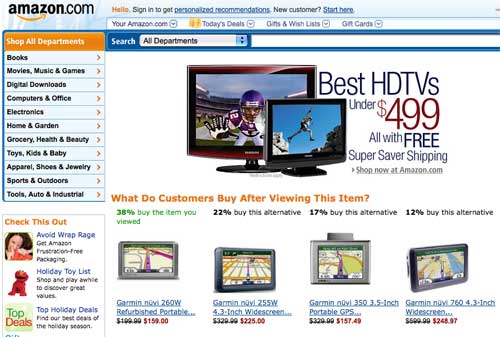Dec 16, 2008 | 5 minute read
Optimizing Landing Pages to Match Customer Motivation
written by Linda Bustos

 Picking up where we left off in the Marketing Experiments Conversion SequenceC = 4m + 3v + 2(i-f) -2a, the last couple posts covered "m" for Motivation discussing optimizing your ecommerce sites for "hunters" on home pages and search and navigation.
Picking up where we left off in the Marketing Experiments Conversion SequenceC = 4m + 3v + 2(i-f) -2a, the last couple posts covered "m" for Motivation discussing optimizing your ecommerce sites for "hunters" on home pages and search and navigation.
Today I want to look at motivation from a different angle. I want you to choose a landing page that is top priority for you to optimize. For example, your most profitable product with the highest abandonment rate. I want to get you thinking about which customer motivations are most likely to match your business, your products, your typical customer and your landing page presentation.
If you haven't read the posts on value propositions yet, you might want to start there as this follows the same line of thought.
Ready?
Alright. First I want you to think why someone would buy online (not just browse and research products), then think about your landing page in light of the product category/industry. "Check all that may apply."
Why a customer chooses to make a purchase online
- Belief you can find cheaper prices online than in stores
- Convenience, can shop in pyjamas
- Better selection, online stores carry larger inventories, more choices with the click of a mouse
- Uniqueness, can find something rare or hard to find
- Product unavailable in store, may be sold out or discontinued (or a size/color not available in store)
At the store level
What is your strength as a store considering your value proposition? Examples:
- GAP items are only sold through GAP retail stores and online. The GAP.com customer is likely a "convenience" shopper loyal to the brand, or looking to find product not available in store.
- UncommonGoods and Threadless are examples of e-stores that carry exclusive products.
- Peapod's strength is convenience. The customer knows he can get frozen vegetables cheaper at the supermarket but will pay a premium for to-your-door service.
- Zappos and Crutchfield's focus on customer service rather than rock bottom prices. Their design, marketing and landing page copy doesn't emulate bargain sites like Classic Closeouts or Tiger Direct.
At the category level
Think about how people shop for different categories. Why would someone purchase this product category online?
Victoria's Secret sells a mix of lingerie and loungewear available only in Victoria's Secret stores, its clothing and accessories are only available online through VictoriasSecret.com, and it sells cosmetic items like Clarins self tanner that are available anywhere.
The online channel has to understand the FUDDs (fears, uncertainties, doubts and deal-breakers) for each category may be different. It's easy to buy lingerie you've tried in-store already, much more risky to purchase clothing sight-unseen which may not fit well, or be true to size or color on the screen.
Why a customer is on your site
- By mistake
- For inspiration / fantasy (thinking of redecorating in 3 months, looking at clothes to purchase once one loses weight)
- To research and compare products to purchase (early in buying stage, researching category or specific models)
- To research online for purchase offline (ROPO)
- To compare prices
- To receive a discount through 3rd party (co-marketing, affiliate site)
- To use a coupon code or redeem a gift card
- Loyalty to store, email subscriber
- Buy something today, online, from you (bookmarked or direct type in)
You can't control or influence why a customer is on your site, but you can attempt to segment them as best you can. For example, you may create different landing pages for affiliates or referrals through coupons and deals sites than for PPC or email offers.
They way you speak to different types of visitors will also depend on why they are at your site. You might consider having a unique landing page for gift card holders, or use a personalization tool recognize a repeat visitor and show recently viewed items on the home page (like Amazon):

How a customer arrived at your site (channel)
- Price comparison engine
- Reviews site
- Affiliate, pre-sold on the virtues of the product
- SEO
- PPC ad
- Email subscriber
- Email forwarded by friend (may not be familiar with your brand)
- Social shopping, browsing Polyvore, for example
- Direct type-in, aware of store already
- Catalog referral
- Television/print
Look at your web analytics for the landing page in question. What's the top referring channel? Does this channel attract a certain type of shopper? For instance, Microsoft Live search engine offers cash back -- is this a bargain shopper? Does this shopper convert higher because they are more likely to be researching an online purchase than researching online to purchase locally?
Even shopping engine users can have different demographics: SHOP.com users are 70% female, and CNet shoppers are more often male. Perhaps landing page copy geared to different sexes would perform better?
Another thing to think about -- what's the poorest performing channel? If your PPC conversion for this page is brutal, it could be your keywords or ad copy are not relevant to the page, or you have a price in the ad copy that is incorrect. It's also important to look at how the keywords you are bidding on match where a searcher is in the buying process. Bryan Eisenberg had a great article on PPC optimization on GrokDotCom yesterday.
Why the customer wants this product
- Purchase role: gift giver
- Industrial buyer
- Personal
- Necessity vs. Luxury
- Pre-sold, through friend's recommendation or article, word of mouth
- Read reviews and otherwise came to the conclusion on their own
At certain times of the year (Christmas, Valentine's, Mother's Day) you can assume a larger proportion of visitors are buying gifts and you may emphasize gift finders, gift wrap options and shipping cutoff dates more prominently than other times of the year. Or, you may have buying guides for men on a jewelry or women's clothing store all year round, understanding they may feel lost on your site.
Buyer personality (intrinsic motivators) matched to purchase situation
Based on Future Now's persuasion architecture, there are 4 general buying modalities customers may fall into based on their personality or based on the nature of a given purchase decision:
- Competitive
- Humanistic
- Methodical
- Spontaneous
Now we're getting into persona development, understanding different customer segments and covering all your bases with persuasive copy for the different buying modalities. It's near impossible if not completely impossible to predict an individual visitor's purchase role and customer personality (with technologies ever improving, we might be able to shortly). But you can optimize your landing pages to "cover all the bases" if you understand what different customer types respond to.
You may be interested in posts we've done relating to marketing to various customer types:
Optimizing Product Reviews by Customer Personality
Making Email Creative Enticing to Everyone
Email Subject Lines and Customer Personality
Persuasive optimization is valuable, but I suggest you think about your basics first. Start with your value proposition and present it clearly on your site. Get comfortable with web analytics and use them to extract insights about customer behavior through various channels. Then get down to the final details of testing, tweaking and persuading.